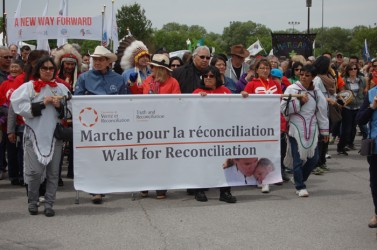Article Origin
Volume
Issue
Year
Truth and Reconciliation Commission members (behind sign from left) Chief Wilton Littlechild, Dr. Marie Wilson and Justice Murray Sinclair lead the Reconciliation Walk.
Thousands of marchers, Aboriginal and non-Aboriginal, crammed Marion Dewar Plaza in Ottawa on May 31 for the first day of the closing ceremony of the Truth and Reconciliation Commission.
“My belief and hope is that Canadians are starting to get it,” said Assembly of First Nation National Chief Perry Bellegarde. “Once that education and awareness process happens it leads to understanding that leads to action and that’s what it’s all about.”
First Nations and Inuit leaders and TRC commissioners were joined by provincial, local and federal politicians, including Aboriginal Affairs Minister Bernard Valcourt, church representatives, Indian residential school survivors, their descendants and community members, in a five-kilometre walk from Ecole Secondaire de l’Ile in Gatineau, Que. across the Portage bridge and Victoria Island down Wellington Street in front of the Parliament buildings to city hall plaza in Ottawa.
Signs along the route, in both provinces, expressed solidarity with the survivors and the work undertaken by the TRC. Car horns were honked and church bells rang out hailing marchers.
“We are all one,” said Chief Robert Joseph, when the marchers reached Ottawa. “We stand at a monumental crossroads today. This
is a historical moment for hope and promise.”
Joseph, who is an honourary witness for the TRC, also serves as the Ambassador for Reconciliation Canada and a member of the AFN Elders Council.
Survivor Annie Johnston, who attended residential schools in British Columbia and the Yukon, said she was heartened by both the non-Aboriginal people who took part in the march and an Anglican
minister and his wife, who walked beside Johnston and her friend Madeleine Jackson, also a residential school survivor.
“(The wife) was apologizing, and Madeleine told her it wasn’t her fault, and she told (Madeleine) it was her ancestors she had to say she was sorry for. It encouraged me,” said Johnston.
Clara Hughes, multiple Olympic medalist and participant in the march, also spoke about her historical involvement.
“I stand here in shame of my ancestors, acknowledging what they have done but also stand here with great pride of being an honourary witness… and vow to be one of the people who corrects the ignorance,” she said to the crowd gathered in Gatineau, where the march began.
Ottawa Mayor Jim Watson greeted the marchers at Marion Dewar Plaza, acknowledging Ottawa’s location on the unceded territory of the Algonquin Nation and noting that, with 35,000 Aboriginal people living and working in the city, Ottawa had the fastest growing urban Aboriginal community in the country.
“We cannot change the past, but we can learn from it. We can recognize those who have been deeply affected and wounded. We
can work together as a community to build a renewed relationship with our Aboriginal community members, one that is based on mutual understanding, appreciation and respect,” he said.
Ontario Premier Kathleen Wynne, who spoke to survivors as she marched, also addressed the group in Ottawa. She talked about her personal connection, saying that her grandchildren’s other set of
grandparents had attended Indian residential school.
“While our federal government has apologized, a statement of apology will only take us so far. To give meaning to those words,
to lift them off the page so they can make a positive difference in people’s lives, government must be active agents in dismantling the system of oppression that they spent centuries building,” said Wynne.
Wynne noted the action her government had taken, including revising school curriculum to include residential schools, distributing First Nations treaty maps to all the schools, and working with partners to develop community-driven, culturally-based programs and services.
TRC Chair Justice Murray Sinclair called the day “meaningful” for the commissioners, but said the work toward reconciliation was far from over.
“Reconciliation will not be achieved in my lifetime…. Reconciliation will probably not be achieved in the lifetime of my children. But reconciliation will be achieved if we understand this: You do not have to believe that reconciliation will happen; you have to believe that reconciliation should happen,” he said.
- 5097 views

